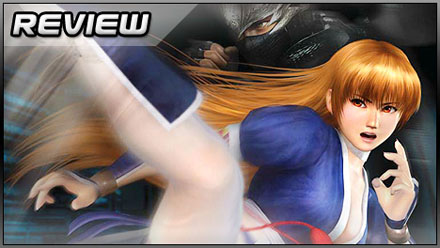
First things first, a frank admission: There are those that genuinely believe Dead or Alive to be a serious competitive fighting game, capable of going toe to toe with the likes of Virtua Fighter, Tekken, Street Fighter and King of Fighters. I am not one of those people. The strike-throw-hold triangle system has all the subtlety of the spherical silicon fun bags that titivate the cast, leaving character selection chiefly down to who has the most abusable multi-level crush moves, with little emphasis on balance or individuality.
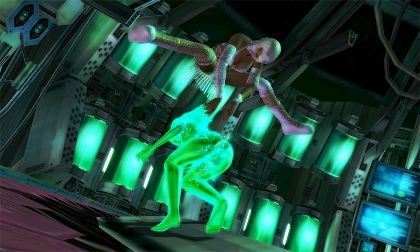
La Mariposa led the charge of luchadors in fighting games -- they're now a staple of nearly every major series.
Yet there is always room for the pulp amongst the pretension, and Dead or Alive has never been afraid to let its hair down in the pursuit of instant gratification. From the arcade original, all the way through to successive Xbox iterations, it has succeeded in delivering cutting-edge visuals, fast-paced exchanges and responsive gameplay. Focusing on fun factor over pesky balance concerns has allowed the series to be more experimental than its po-faced rivals – environmental hazards, dynamic arenas and hectic four-player tag battles are just some of DoA’s triumphs. And if all else fails, there’s always tits.
So why the history lesson when there’s a shiny new 3DS iteration begging for attention? Well there’s the rub. DoA Dimensions is a history lesson, squeezing the last fifteen years of DoA conflict onto a card no bigger than a nipple. Essentially built on a modified version of 2005’s DoA4 system, Dimensions pools every character in the series to date, including the series trademark overpowered bosses, but obviously excluding Halo’s Spartan-458.
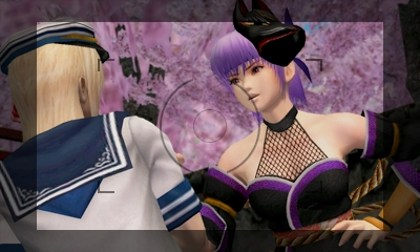
Each character has nearly 50 figures to collect and pose in as many suggestive ways as your imagination can muster.
At the centre of this battle royale is chronicle mode; a chronological recounting of the Dead or Alive saga’s narrative events all the way from the first game to the fourth. Putting you in the shoes of each game’s protagonists, chronicle blends previous games’ FMV cut-scenes with exclusive new real-time story sequences as you gel together the entire tale, from Raidou’s betrayal to Helena’s reclaiming of DOATEC. Bizarrely this takes place over five chapters, and as the story resolves itself by chapter four (as per game), chapter five is redundant and reuses previous cut-scenes while adding nothing new to the story.
While the previous titles’ FMV cut-scenes are presented in their usual glory (with varying degrees of codec clarity it must be said) the real-time scenes lack any facial animation, and with the chatter incessant as it is, it really stands out. As a story delivery vehicle it’s successful, answering any lingering questions you might have about character motivations, rivalries and the like, but then your enjoyment of this is going to be largely dependent on how much the DoA story does for you. For most people, this won’t be a great deal.
Arcade and Survival modes dispense with the drama and offer a straight-forward combat experience with a variety of courses and unlockables, but it’s Dead or Alive’s once-thrilling tag team mode that’s undergone the greatest change. Now, rather than one player controlling both characters in the tag battle, the CPU handles your partner. I intentionally refer to it as the CPU rather than AI as it displays no semblance of intelligence whatsoever. Your partner will routinely stand vacantly absorbing hits forcing you to switch back in, forgoing any health-replenishing rest you had in mind.
Worse still is the lack of dedicated tag button, with practically any direction or button you press resulting in an unwanted tag to your dim-witted partner, regularly overlapping commands, making move execution an exercise in frustration. It’s a pity to see one of the series’ strengths ruined for absolutely no sensible reason.
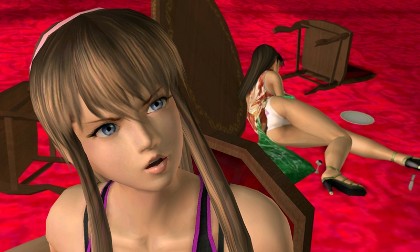
The unlockable costumes don't feature quite the level of fan service as previous games in the series and the trademark bounce is less prominent on Nintendo's hardware. There are still scenes like this however.
Showcase mode gives you the option of creating your own dioramas using collectable figurines and taking snaps of them that you can view in a 3D photo album, though it joins many other 3DS titles than use 3D in conjunction with the gyroscope in meshing two contradictory features that refuse to play nice together. The same could be said of the game’s entire approach to 3D, as running the game as Nintendo intended halves the frame rate to a very beat ‘em up unfriendly 30fps. Keep that slider turned to empty however and Dimensions shines with crisp, detailed models kicking and punching their way through beautiful backdrops at a consistent arcade-spec 60fps.
The majority of the series’ iconic environments make the cut, albeit without the full range of topographical variation, and some of the more processor-intensive arena such as DoA 4’s dinosaur-filed Experimental Playground are understandably absent. The Geothermal Power Plant stage is the product of Nintendo and Team Ninja’s Metroid: Other M collaboration and Ridley’s meddlesome interference makes for a neat Easter egg, even if it’s introduced with little to no fanfare.
Dimensions convincingly parries that most perennial of portable fighting game problem – controls. Due in no small part to the inherent ease of the series’ controls to begin with, the full range of moves are simple to execute, and even if you do find a particularly complex command, the bottom screen allows touch screen access to the complete list of your character’s move set. DoA’s trademark hold system has been refined once again with the active window for successfully countering a strike returning to DoA 3’s generous levels, following the more demanding fourth game.
Local and Internet versus modes are present, but were sadly unavailable for testing at the time of review, though Team Ninja’s head ninja Yosuke Hiyashi has promised it uses the very same net code as DoA 4 — hardly a ringing endorsement. As with any fighting game, this is where the majority of your time should be spent and with online stability such an unknown quantity, your purchasing decision should perhaps take into account how many DoA-committed friends you have.
Following a decade of Microsoft exclusivity, this greatest hits compilation might well make a greater splash in its homeland by appearing on a more Japan-friendly console, and if this leads to a true fifth chapter in the series it will have served a good purpose. DoA is at its best when pushing consoles to the limit with cutting-edge tech, and sadly not only does the 3DS tech fail to offer anything relevant to the series but we’ve seen all the content before too. However, for fans this is a very complete package, and for newcomers, it’s an accessible and well presented fighting romp.


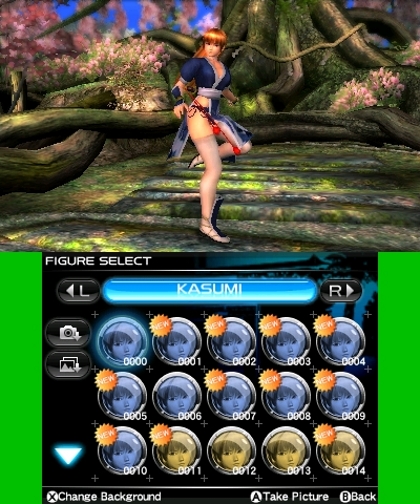
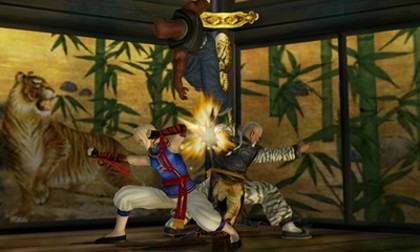




 Satoru Iwata Video Interview - the late Nintendo president spoke with Kikizo in 2004 as 'Nintendo Revolution' loomed.
Satoru Iwata Video Interview - the late Nintendo president spoke with Kikizo in 2004 as 'Nintendo Revolution' loomed. Kaz Hirai Video Interview - the first of Kikizo's interviews with the man who went on to become global head of Sony.
Kaz Hirai Video Interview - the first of Kikizo's interviews with the man who went on to become global head of Sony. Ed Fries Video Interview - one of Xbox's founders discusses an epic journey from Excel to Xbox.
Ed Fries Video Interview - one of Xbox's founders discusses an epic journey from Excel to Xbox. Yu Suzuki, the Kikizo Interview - we spend time with one of gaming's most revered creators.
Yu Suzuki, the Kikizo Interview - we spend time with one of gaming's most revered creators. Tetris - The Making of an Icon: Alexey Pajitnov and Henk Rogers reveal the fascinating story behind Tetris
Tetris - The Making of an Icon: Alexey Pajitnov and Henk Rogers reveal the fascinating story behind Tetris Rare founders, Chris and Tim Stamper - their only interview? Genuinely 'rare' sit down with founders of the legendary studio.
Rare founders, Chris and Tim Stamper - their only interview? Genuinely 'rare' sit down with founders of the legendary studio. The History of First-Person Shooters - a retrospective, from Maze War to Modern Warfare
The History of First-Person Shooters - a retrospective, from Maze War to Modern Warfare
decent score.
yo mnan! It’s been a long time since I’ve read your interviews man!
where is another interview with Yosuke Hayashi? he’s the boss of Team NINJA now. Back then when you interviewed him, he was a director
DOA is unbalanced ? LOL this guy is an idot who has no idea what he is talking about ! DOA is better then Tekken in every way, And ummm excuse me isnt Tekkens Boss a giant beast ? U R AND IDIOT !